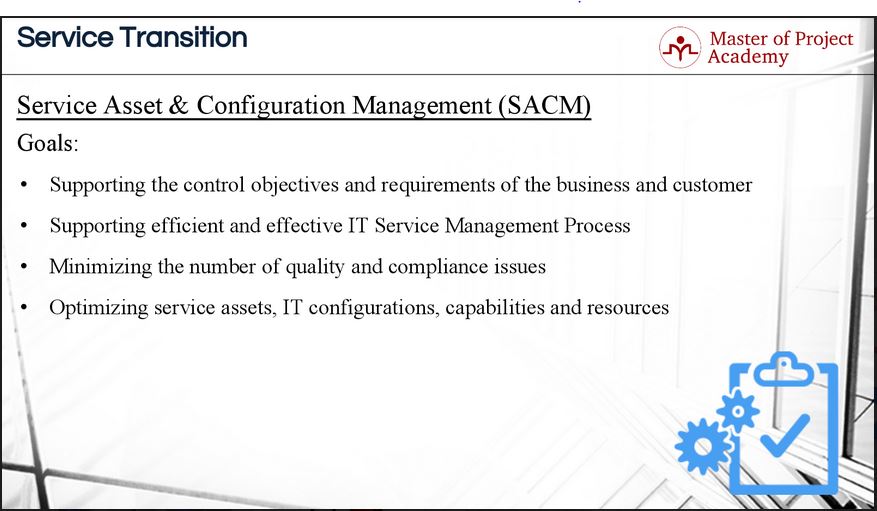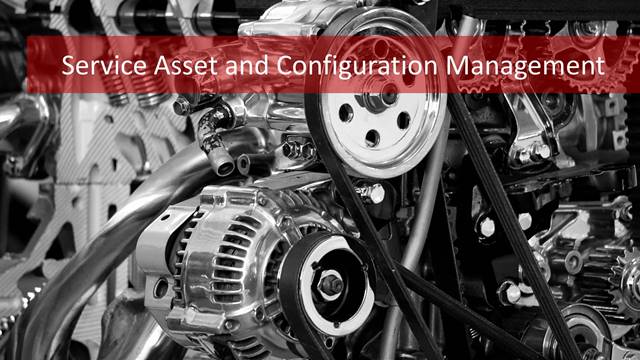ITIL Change Management is an important process in the ITIL Service Transition stage of the ITIL service lifecycle and service asset and configuration management is part of the change management process. There are several definitions, goals, and objectives that a service owner must understand in order to successfully apply service asset and configuration management. These are discussed in detail in ITIL courses. Understanding how to efficiently and effectively apply service asset and configuration management within the ITIL framework is one of the goals of ITIL foundation certification training.
Definitions in Service Asset and Configuration Management
Asset
Let’s start with the definition of an asset. The dictionary definition of an asset is a useful or valuable thing or person. Similarly, assets of an IT service provider are its tools, applications, configuration items, and any other valuable items that help to deliver services to the customers or business. Assets are one part of service asset and configuration Management.
Configuration Item
Configuration Item is abbreviated as CI and a configuration item is any component that needs to be managed in order to deliver an IT Service. Examples of configuration items are IT services, hardware, software, buildings, people and formal documentation. So briefly, any component or item that helps to deliver an IT service to the customer is classified as a Configuration Item. Information about each configuration item is recorded in a Configuration Record within the Configuration Management System and this information is maintained through its lifecycle by Configuration Management.
Configuration record includes the properties, specifications, and requirements of a configuration item in order to be used in compliance with other services in an IT service provider. A configuration record of a configuration item must be kept up to date in the configuration management system in order to eliminate any inconsistency of the configuration items with each other. And all configuration items of an IT service provider are under the control of the service asset and configuration management process and in turn of IT Change Management.

Configuration Management Database
Configuration Management database is abbreviated as CMDB. CMDB is a database used to store configuration records throughout their lifecycle. There will be several assets in an IT service provider. If we consider a service, it will have several revisions and releases throughout its lifecycle due to new requests or due to fixes for the encountered problems. All these updates and attributes of the services are kept in configuration records. These configuration records of the several configuration items are stored and maintained in Configuration Management Database. The Configuration Management System of an IT Service Provider maintains one or more CMDBs. Each CMDB stores attributes of configuration items and relationships with other configuration items.
For instance, fingerprint detection software of a bank’s ATM can be at version 2.1. For this configuration item to work properly, a fingerprint detection device must have at least version 5.2 or more. These kinds of relationships of each configuration item with each other are included in the CMDB. The CMDB is an important feature of service asset and configuration management.
Configuration Management System
Configuration Management system is abbreviated as CMS and is a set of tools and databases that are used to manage an IT Service Provider’s Configuration Data. Data about configuration items are stored in configuration records, and configuration records are included in the Configuration Management System Databases. The CMDBs of an IT Service provider to manage the configuration data is included in the service asset and configuration management process.
The Configuration Management System also includes information about incidents, problems, known errors, changes and releases, employees, suppliers, locations, business units, customers, and users. In summary, all necessary information about configuration items and IT assets are included in the Configuration Management System. When needed, this information is acquired from the CMS and used respectively. The CMS plays an important role in service asset and configuration Management.
The CMS includes tools for collecting, storing, managing, updating and presenting data about all configuration items and their relationships. So the configuration management does not only include data about the configuration items but also tools for collecting, storing and managing these data. These are all part of the configuration management system as well. For instance, if problems are created, tracked and managed through an issue tracking tool in an IT Service Provider, it is part of the Configuration Management System.
The goals of service asset and configuration management
Service Asset and Configuration Management mainly deals with the management of the tools, configuration items, releases and versions of the systems or software in an IT Service Provider. Supporting the control objectives and requirements of the business and customer is one of the goals of the service asset and configuration management process. In order to ensure a consistent and comprehensive service delivery to the customer, releases or revisions of each configuration item, service, tool or application must be compliant with each other. The service asset and configuration management process mainly aims to keep control of the releases and revisions of these items.

Supporting an efficient and effective IT Service Management process is another goal of the service asset and configuration management process. For instance, today the latest version of the Windows operating system is Windows 10. Can you image installing this operating system to a ten-year-old computer? Most probably no, because the minimum system requirements for Windows 10 will not be compliant with the specifications of an old computer. Similarly, there are several services configuration items, tools and applications running in an IT service provider to deliver quality service to the customers. All these must be compliant with each other to ensure an efficient and effective management of IT service delivery. This is achieved with efficient service asset and configuration management.
Minimizing the number of quality and compliance issues are achieved through a service asset and configuration management process. Since revisions or releases of each software, tool, and configuration item and their compliance with each other are controlled under the goal of the service asset and configuration management process, quality and compliance related issues will be reduced as a result.
Optimizing service assets, IT configurations, capabilities and resources is another goal of the service asset and configuration management process. Since revisions and releases of the service assets and their compliance with each other are part of the service asset and configuration management process, optimization of these assets, configurations, capabilities and resources are done as a goal of service asset and configuration management process as well.
The objectives of Service Asset and Configuration Management
There are two fundamental objectives of the service asset and configuration management process.
The first objective of service asset and configuration management is defining and controlling components of services and infrastructure. Effective and efficient ITIL service management can be ensured only by compliant IT assets. For instance, if a money withdrawal service of a bank uses one hundred IT services, all these services must be working properly with each other. However, each service will have its versions and revisions due to improvements or fixes. Therefore, the definition and control of these service assets is an objective of the service asset and configuration management process.
The second objective of service asset and configuration management is maintaining accurate configuration information on historical, current and planned state of services and infrastructure. For instance, there might be a new feature request from the business and due to this request, a newer version of a service might be required. The service asset and configuration management process aims to control and check that this newer version of the service will be working properly with the other interacted services in the IT service provider.
The successful completion of the ITIL Service Transition stage relies on effective and efficient service asset and configuration management as part of the change management process. Without proper service asset and configuration management, the ITIL Service Transition stage will be weak and it might not be possible to progress to the next stage of the ITIL lifecycle. Service asset and configuration management is vital to the ITIL Service Transition stage.
Review by: Lydia Jennings


2 thoughts on “IT Service Asset and Configuration Management: All You Need to Know”
Comments are closed.